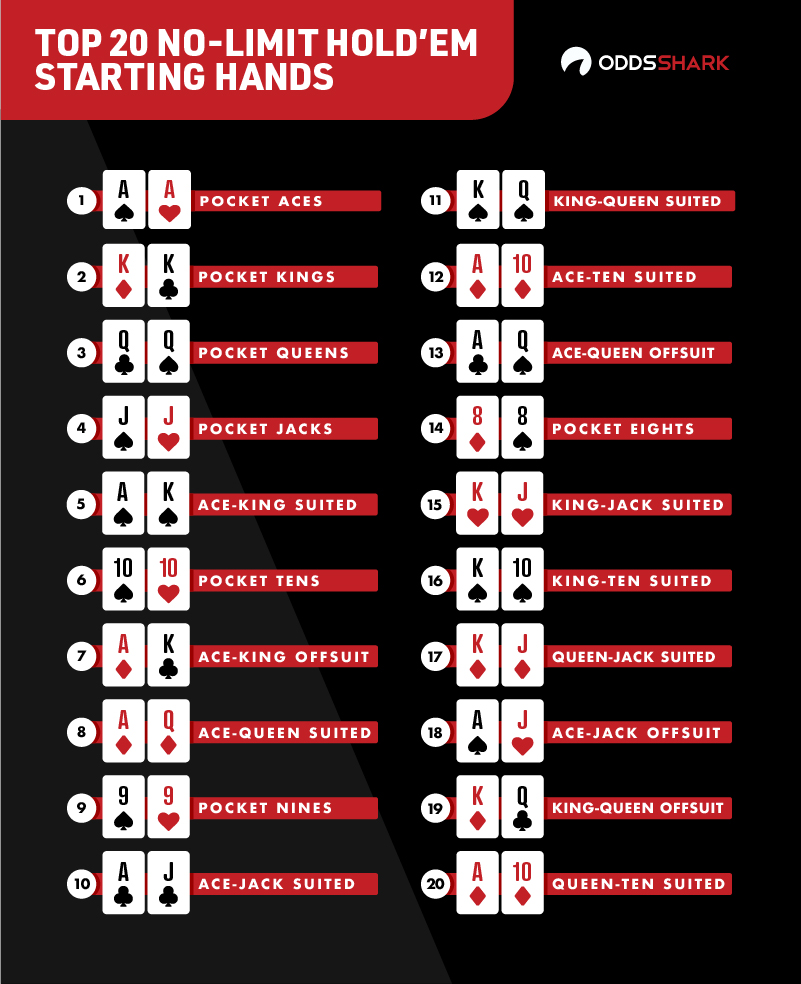The truth is, most good players play the majority of their hands in position — by a lot, in fact. That's because when it comes to starting poker hand selection, good players tend to fold more. Poker Starting Hand Chart (6-max Cash, 100bb): Hand Chart Notation Getting to know which hands to play and in which positions is even more important than the actual hand. This 6-max Cash Hand Chart details the hands you should play and the position.
Online Poker » Poker Strategy » Texas Hold Em » Position Free casino roulette no download slots.
A big mistake that many new poker players tend to make when first starting out is often playing too many hands and worse yet, playing all of these hands out of position. This of course results in players often playing a hand that is second best and being first to act with this hand on all sequential betting rounds. This will prove to be -EV over a long period and for a newer player, quite damaging to his or her bankroll.
Poker Table Position
So, what is poker table position? Well, poker table position refers to where a player is sitting in relation to the dealer button. To better understand, imagine a 9 handed poker table split into 3 sections. The first section would consist of the first 3 players to the left of the dealer button: the small blind, big blind, and the player under the gun. This section is known as early position, or EP for short, and these players can be labeled as EP+1, EP+2 and EP+3 starting with the earliest player.
The next 1/3 of the poker table is referred to as middle position. The players that are in this position will be labeled as MP+4, MP+5 and MP+6 starting with the seat closest to the EP+3 player.
Lastly, the last 1/3 of the poker table consists of the best seats during that hand. This section is referred to as late position and consists of the hi-jack, the cutoff and the button with the button being the best seat to be in. These players are labeled as LP+7, LP+8 and LP+9.
Ok, so now that you know what table position is and where you may be sitting in relation to the dealer and your opponents, now it is important to know why table position matters.
Why is Table Position Important?


Table position is important to understand and use simply because poker is a game of information. The more you have, the better off you will be.
For example, let's assume that you were just dealt Ah-Qs and are the player under the gun which means you are the first to act. The blinds are 50/100 and you decide to put in a raise of $300. Everyone folds up to the button who comes over the top with a $1,200 re-raise, so $900 more for you to call.
Stack sizes, player reads and other tidbits aside, this is a sticky situation with a hand that is not even a coin flip against even the smallest of pocket pairs and is dominated by A-K, KK and AA. This is a situation where you are probably going to have to fold your hand thus wasting 300 chips that you very well could have used in a better spot.
But if you only knew that the player on the button was going to re-raise you, you could have folded your hand. Being first means that you will have a lack of knowledge on every street you play.
Ok, so let's reverse the rolls here. You have the same hand but are on the button with the blinds still at 50/100. The player under the gun decides to raise it $275. One player calls with everyone else folding to you. What do you do?
Again, Ah-Qs is not a very strong hand and is worth playing only if you can do so if you are the first to act in late position. But since there was a raise and another player called that raise, your hand is more than likely behind. So, you would just fold here.
You folded because you knew you were behind and calling would be a waste of chips. You knew this because you were able to watch what everyone else decided to do before it was your turn to act.
From these two examples you should see the night and day difference between sitting in early position compared to sitting in later position. Early position hinders your knowledge of your opponents and their possible holdings which makes your decisions harder to make.
Being in later position obviously is the best with the best seat of the house being the button. From here a player can witness all the action and be able to act last on all betting rounds allowing them to make the most educated choices possible. Many of these educated choices are what starting hands to play.
Texas Hold'em Starting Hands - Table Position
Now, position was discussed before the starting hands were because it makes the reasoning behind these starting hands much clearer. The earlier you are to act, the stronger the hand you want to have to avoid sticky situations such as the one outlined above.
Here are the hands we suggest players play and from where:
* Early Position: AA-QQ, A-K
* Middle Position: AA-1010, A-K, A-Q
* Late Position: AA-77, A-K to A-10, suited connectors
These starting hand requirements are obviously going to vary depending on your situation. Also, most of the hands in middle and late position are only if you are first to act, not if you are facing a raise. This is known as the Gap Concept and in these situations, you will want to have a minimum hand range that is comparable to where your opponent is raising from. For example, if an opponent raised from EP you could not flat call with all of your late position hand range, but would have to call with a hand that you would play in similar position that he's raising from. Since he's raising from EP, you would need a hand from your EP hand range to call, or arguably make a re-raise.
Poker Table Position - Starting Hands in Poker

Table position is important to understand and use simply because poker is a game of information. The more you have, the better off you will be.
For example, let's assume that you were just dealt Ah-Qs and are the player under the gun which means you are the first to act. The blinds are 50/100 and you decide to put in a raise of $300. Everyone folds up to the button who comes over the top with a $1,200 re-raise, so $900 more for you to call.
Stack sizes, player reads and other tidbits aside, this is a sticky situation with a hand that is not even a coin flip against even the smallest of pocket pairs and is dominated by A-K, KK and AA. This is a situation where you are probably going to have to fold your hand thus wasting 300 chips that you very well could have used in a better spot.
But if you only knew that the player on the button was going to re-raise you, you could have folded your hand. Being first means that you will have a lack of knowledge on every street you play.
Ok, so let's reverse the rolls here. You have the same hand but are on the button with the blinds still at 50/100. The player under the gun decides to raise it $275. One player calls with everyone else folding to you. What do you do?
Again, Ah-Qs is not a very strong hand and is worth playing only if you can do so if you are the first to act in late position. But since there was a raise and another player called that raise, your hand is more than likely behind. So, you would just fold here.
You folded because you knew you were behind and calling would be a waste of chips. You knew this because you were able to watch what everyone else decided to do before it was your turn to act.
From these two examples you should see the night and day difference between sitting in early position compared to sitting in later position. Early position hinders your knowledge of your opponents and their possible holdings which makes your decisions harder to make.
Being in later position obviously is the best with the best seat of the house being the button. From here a player can witness all the action and be able to act last on all betting rounds allowing them to make the most educated choices possible. Many of these educated choices are what starting hands to play.
Texas Hold'em Starting Hands - Table Position
Now, position was discussed before the starting hands were because it makes the reasoning behind these starting hands much clearer. The earlier you are to act, the stronger the hand you want to have to avoid sticky situations such as the one outlined above.
Here are the hands we suggest players play and from where:
* Early Position: AA-QQ, A-K
* Middle Position: AA-1010, A-K, A-Q
* Late Position: AA-77, A-K to A-10, suited connectors
These starting hand requirements are obviously going to vary depending on your situation. Also, most of the hands in middle and late position are only if you are first to act, not if you are facing a raise. This is known as the Gap Concept and in these situations, you will want to have a minimum hand range that is comparable to where your opponent is raising from. For example, if an opponent raised from EP you could not flat call with all of your late position hand range, but would have to call with a hand that you would play in similar position that he's raising from. Since he's raising from EP, you would need a hand from your EP hand range to call, or arguably make a re-raise.
Poker Table Position - Starting Hands in Poker
Texas Holdem Starting Hand Percentages
As you can see, it is very important to have an understanding of position in poker and how it relates to all of the decisions you make, namely what hands you choose to play and from where. This will prevent you from making plays based solely on your two cards which many times can prove you to be second best thus resulting in the loss of your stack. Better yet, when you have a firm understanding of position you can then focus on great strategic moves such as poker floating and various check-raising techniques that are primarily used while in position against an opponent. Just always remember that position is very similar to the game of poker, it is always changing; just be sure you adapt and play accordingly.
